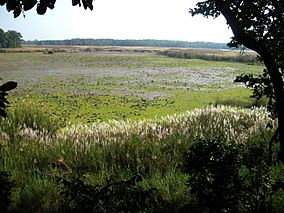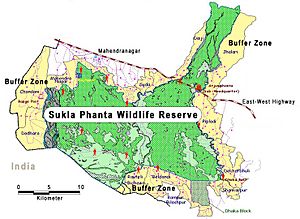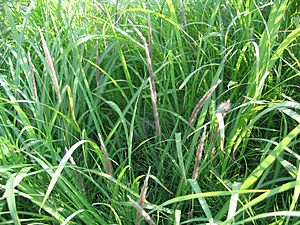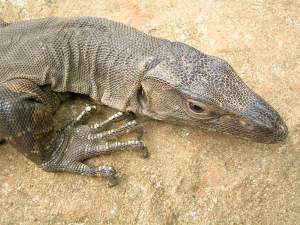Shuklaphanta National Park facts for kids
Quick facts for kids Shuklaphanta National Park |
|
|---|---|
| शुक्लाफाँटा राष्ट्रिय निकुन्ज | |
|
IUCN Category II (National Park)
|
|

Rani Tal, a lake inside Shuklaphanta National Park
|
|
| Location | Nepal, Province No. 7 |
| Nearest city | Bhimdatta |
| Area | 305 km2 (118 sq mi) |
| Established | 1976 (2017 - National Park) |
| Governing body | Department of National Parks and Wildlife Conservation |
| Website | Shuklaphanta National Park |
The Shuklaphanta National Park is a special protected area in the Terai region of Nepal. It covers about 305 square kilometers (118 square miles). This park is a mix of open grasslands, thick forests, riverbeds, and wet areas called wetlands. It sits at different heights, from 174 meters (571 feet) to 1,386 meters (4,547 feet) above sea level.
The park was first set up in 1976 as the Royal Shuklaphanta Wildlife Reserve. A small part of the park is north of the East-West Highway. This helps animals move freely during their seasonal migrations into the Sivalik Hills. The Syali River forms the park's eastern edge. The border with India makes up its southern and western boundaries.
Right next to Shuklaphanta National Park, in India, is the Kishanpur Wildlife Sanctuary. This area is about 439 square kilometers (169 square miles). Together, these two areas are very important for protecting tigers. They form a large area of grasslands and forests where tigers can live safely.
This protected area is part of the Terai-Duar savanna and grasslands ecoregion. It is one of the best examples of floodplain grasslands that are still well-preserved. It is also part of the larger Terai Arc Landscape, which aims to connect and protect wildlife habitats across Nepal and India.
Contents
History of Shuklaphanta National Park
Long ago, the area that is now Shuklaphanta National Park was a hunting ground for Nepal's rulers. In 1969, it was officially made a Royal Hunting Reserve. Then, in 1973, it became the Royal Sukla Phanta Wildlife Reserve. At first, it was 155 square kilometers (60 square miles) big.
The park grew to its current size in the late 1980s. In 2004, a buffer zone of 243.5 square kilometers (94 square miles) was added around it. This buffer zone helps protect the park and supports local communities. In 2017, the protected area was given a new, higher status and became a national park.
The name Suklaphanta comes from a large grassland inside the park. This main grassland, called Sukla Phanta, is the biggest continuous grassland in Nepal. It covers about 16 square kilometers (6.2 square miles).
The jungles of Shuklaphanta National Park were once home to an ancient kingdom. You can still see old ruins in some places. Near Rani Tal, a lake in the park, there is a brick wall that measures 1,500 meters (4,900 feet) around. Local people believe it is what's left of a fort built by the Tharu king Singpal.
Climate and Weather in the Park
The climate in Shuklaphanta National Park is a subtropical monsoon climate. This means it has distinct wet and dry seasons. The average rainfall here is about 1,579 millimeters (62 inches) each year. Most of this rain falls from June to September, with August being the wettest month.
The winter months, December and January, are quite cold. Daytime temperatures during this time are usually between 7°C and 12°C (45°F and 54°F). Sometimes, you might even see frost. From February onwards, temperatures start to rise. By March, they can reach up to 25°C (77°F). The hottest time is usually by the end of April, when temperatures can hit 42°C (108°F). When the first pre-monsoon rains arrive in May, the air becomes more humid.
Plants and Trees of Shuklaphanta
Shuklaphanta National Park is home to about 700 different kinds of plants. This includes 553 vascular plants, which are plants with special tissues to carry water and nutrients. Among these are 18 types of ferns, 410 dicots (plants with two seed leaves), and 125 monocots (plants with one seed leaf).
Almost half of the park's plant life is made up of grasslands. The most common grass species are Imperata cylindrica and Heteropogon contortus. In the wet areas around the seven small lakes, you can find tall khagra reed (Phragmites karka) and Saccharum spontaneum.
The main type of forest in the park is made of sal trees. Along the rivers, you can see khair and sissoo trees. One big challenge for the park's grasslands is that trees are starting to grow in them. Trees block sunlight from the grasses that need it to grow. Tree seeds spread easily and often sprout near existing trees. Also, trees help shade-loving grasses grow, which can push out the sun-loving species. Over time, this natural process can turn grasslands into woodlands.
Animals of Shuklaphanta National Park
The park's open grasslands and wetlands around the lakes provide a home for many different animals. In the rivers, lakes, and ponds, scientists have found 28 types of fish. There are also 12 species of reptiles and amphibians. These include fish like mahseer and rohu, as well as mugger crocodiles, Indian rock pythons, monitor lizards, Indian cobras, common kraits, and Oriental ratsnakes.
Mammals of the Park
The park is home to 46 different kinds of mammals. Eighteen of these are protected by international agreements (CITES). These include amazing animals like the Bengal tiger, Indian leopard, sloth bear, swamp deer, elephant, and hispid hare. Some great one-horned rhinoceros were even moved here from Chitwan National Park to help their population grow.
Shuklaphanta National Park has the largest group of swamp deer in the world living in its grasslands. In 2013, there were 2,170 swamp deer in the park. The population of hispid hare here is also very important globally. In 2016, a rusty-spotted cat was seen for the first time in the park using a special camera-trap.
Birds of the Park
A total of 423 different bird species have been seen in Shuklaphanta National Park. The park has the largest population of Bengal floricans in Nepal. It is also an important place for birds like the swamp francolin, Jerdon's bushchat, rufous-rumped grassbird, chestnut-capped babbler, and Jerdon's babbler. The park is the westernmost place where you can find the swamp francolin and the easternmost place for Finn's weaver. It is also a very important place for Hodgson's bushchat to spend the winter.
Forest birds you might see include the spot-bellied eagle owl, dusky eagle owl, rufous-bellied eagle, and Oriental pied hornbill. The forests are also important for the great slaty woodpecker and white-naped woodpecker. Birds that live and breed in the park include the white-rumped vulture, slender-billed vulture, lesser adjutant, grey-headed fish eagle, darter, and rufous-rumped grassbird.
Some birds visit the park during certain seasons. The Sarus crane, painted stork, and bristled grassbird are summer visitors. The greater racquet-tailed drongo, white-capped water redstart, rusty-tailed flycatcher, and rufous-gorgeted flycatcher visit in winter, but they are not very common.
Images for kids
See also
 In Spanish: Parque nacional Shuklaphanta para niños
In Spanish: Parque nacional Shuklaphanta para niños








